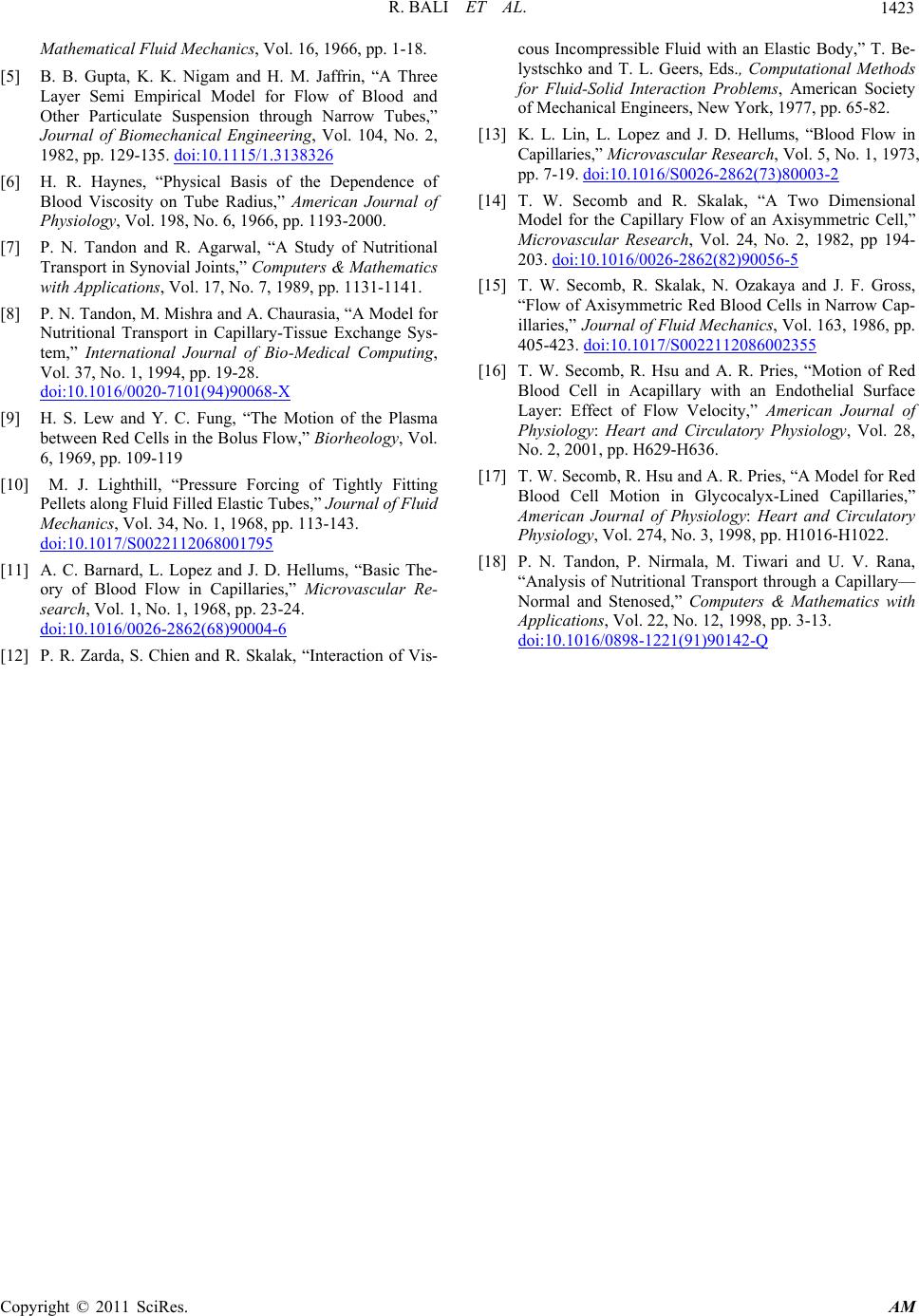
R. BALI ET AL.
Copyright © 2011 SciRes. AM
1423
and H. M. Jaffrin, “A Three
Mathematical Fluid Mechanics, Vol. 16, 1966, pp. 1-18.
[5] B. B. Gupta, K. K. Nigam
Layer Semi Empirical Model for Flow of Blood and
Other Particulate Suspension through Narrow Tubes,”
Journal of Biomechanical Engineering, Vol. 104, No. 2,
1982, pp. 129-135. doi:10.1115/1.3138326
[6] H. R. Haynes, “Physical Basis of the Dependence of
Blood Viscosity on Tube Radius,” American Journal of
Physiology, Vol. 198, No. 6, 1966, pp. 1193-2000.
1.
,
[7] P. N. Tandon and R. Agarwal, “A Study of Nutritional
Transport in Synovial Joints,” Computers & Mathematics
with Applications, Vol. 17, No. 7, 1989, pp. 1131-114
[8] P. N. Tandon, M. Mishra and A. Chaurasia, “A Model for
Nutritional Transport in Capillary-Tissue Exchange Sys-
tem,” International Journal of Bio-Medical Computing
Vol. 37, No. 1, 1994, pp. 19-28.
doi:10.1016/0020-7101(94)90068-X
[9] H. S. Lew and Y. C. Fung, “The Motion of the Plasma
between Red Cells in the Bolus Flow,”
6, 1969, pp. 109-119
Biorheology, Vol.
o. 1, 1968, pp. 113-143.
[10] M. J. Lighthill, “Pressure Forcing of Tightly Fitting
Pellets along Fluid Filled Elastic Tubes,” Journal of Fluid
Mechanics, Vol. 34, N
doi:10.1017/S0022112068001795
[11] A. C. Barnard, L. Lopez and J. D. Hellums, “Basic The-
ory of Blood Flow in Capillaries,” Microvascu
search, Vol. 1, No. 1, 1968, pp. 23-
lar
24.
Re-
doi:10.1016/0026-2862(68)90004-6
[12] P. R. Zarda, S. Chien and R. Skalak, “Interaction of Vis-
cous Incompressible Fluid with an Elastic Body,” T. Be-
lystschko and T. L. Geers, Eds., Computational Methods
for Fluid-Solid Interaction Problems, American Society
of Mechanical Engineers, New York, 1977, pp. 65-82.
[13] K. L. Lin, L. Lopez and J. D. Hellums, “Blood Flow in
Capillaries,” Microvascular Research, Vol. 5, No. 1, 1973,
pp. 7-19. doi:10.1016/S0026-2862(73)80003-2
[14] T. W. Secomb and R. Skalak, “A Two Dimensional
Model for the Capillary Flow of an Axisymmetric Cell,”
Microvascular Research, Vol. 24, No. 2, 1982, pp 194-
203. doi:10.1016/0026-2862(82)90056-5
[15] T. W. Secomb, R. Skalak, N. Ozakaya and J. F. Gross,
“Flow of Axisymmetric Red Blood Cells in Narrow Cap-
illaries,” Journal of Fluid Mechanics, Vol. 163, 1986, pp.
405-423. doi:10.1017/S0022112086002355
[16] T. W. Secomb, R. Hsu and A. R. Pries, “Motion of Red
. Pries, “A Model for Red
,
Blood Cell in Acapillary with an Endothelial Surface
Layer: Effect of Flow Velocity,” American Journal of
Physiology: Heart and Circulatory Physiology, Vol. 28,
No. 2, 2001, pp. H629-H636.
[17] T. W. Secomb, R. Hsu and A. R
Blood Cell Motion in Glycocalyx-Lined Capillaries,”
American Journal of Physiology: Heart and Circulatory
Physiology, Vol. 274, No. 3, 1998, pp. H1016-H1022.
[18] P. N. Tandon, P. Nirmala, M. Tiwari and U. V. Rana
“Analysis of Nutritional Transport through a Capillary—
Normal and Stenosed,” Computers & Mathematics with
Applications, Vol. 22, No. 12, 1998, pp. 3-13.
doi:10.1016/0898-1221(91)90142-Q